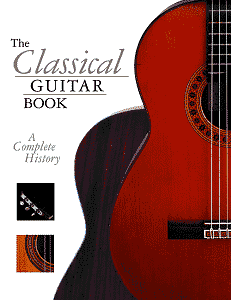A more attractively presented pictorial book on the
classical guitar I cannot imagine. It measures 32cm by 25cm, has 126
pages and is packed with beautiful colour pictures, with a small number
in black and white; the main photographs being the work of Miki Slingsby.
Selected guitars are presented on foldout pages, which display them
to great effect. Unfortunately, it is a rather fiddly job to release
the folded leaf out of the spine of the book as it is a close fit, trimming
the page back a centimetre would have been most beneficial.
Based on the Russell Cleveland Collection, the book
includes a brief history of the guitar starting with references as far
back as Ancient Greece, through to the Renaissance, the Baroque and
up to the small-bodied guitars as played by Fernando Sor (1778-1839)
and Dionisio Aguado (1784-1849). It was these small-bodied guitars that
were the predecessors of the modern guitar, upon which this book is
mainly focused. There are also sections devoted to the anatomy of the
modern guitar, with examples of various strutting, and a guitar, which
is broken down into its constituent parts by the English luthier Paul
Fischer, who is also an acting consultant on the book. The volume also
covers woods favoured by the different makers, the science involved
in construction, the future of the instrument - in fact all the aspects
connected to the guitar in this form, are dealt with in a logical and
informative way. There are biographies of the principal players and
their association with certain makers. It is in this area that we are
treated to Graham Wade’s insights into John Williams, and in particular
Andrès Segovia, on whom Wade must rank as one of the foremost
authorities. There is also a discography of recordings by a wide range
of players.
One can tell from the foreword to the book, written
by Russell Cleveland himself, that he is engaged in something of a love
affair with the guitars in his collection. He describes their individual
sounds and characters - the obvious joy of his life. This devotion is
maintained throughout the book through the writings of the formidable
array of scholars. These include Colin Cooper, editor of the Classic
Guitar magazine, Brian Jeffery, author of probably the definitive
book on Fernando Sor and Dr Bernard Richardson whose work in the field
of the acoustics of stringed instruments is highly regarded, as well
as the aforementioned Graham Wade. I name but a few, who have collaborated
to impart their knowledge and, in many cases, their findings from lifelong
study of the subject.
The core of the book concentrates on what is regarded
today as the modern instrument as envisaged by the maker Antonio Torres
(1817-1892), a guitar of greater power and projection. In doing this
he more or less standardised, for subsequent luthiers, the body’s dimensions
and string length. For the most part experimentation by the following
generations of makers focused on the strutting of the top of the guitar,
some improving on Torres’ original concepts, some not.
Starting with Torres, this book maps the progress of
the luthier’s craft through its most significant makers from all over
the world, including the family dynasty of Ramírez. It was Manuel
Ramírez who in 1912 supplied the great Andrès Segovia
with his first proper concert guitar. Also featured are the Hauser family,
now into their third generation, as are the Fleta family. Both of these
makers also produced guitars played not only by Segovia, but also by
many of the other finest guitarists in the world.
The roll-call of great guitars and their makers continues
down through the years, Simlicio 1925, Santos Hernánez 1933,
Bouchet 1955, Rubio 1966, to mention only five of the thirty-four featured,
up to a 1996 José Romanillos guitar. Romanillos made the guitar
that Julian Bream used on many of his famous recordings and concerts.
Each maker’s work is accompanied by a text outlining his life. Additional
photos highlight the details of headstocks, labels, machine heads and
rosettes. Also listed are the specifications (dimensions, weight and
string lengths, etc) of many guitars.
At the price of £19.95 (my copy is soft backed) this
book is an absolute gift. Not only is it a visual feast it is also packed
with facts and information that one can return to with pleasure time
after time.
Andy Daly


